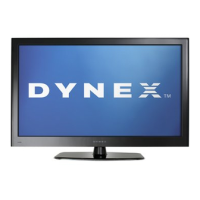Why are some settings grayed out on my Dynex DX-55L150A11?
- JJeffrey WashingtonSep 9, 2025
If some settings on your Dynex LCD TV cannot be accessed (grayed out), it means that the setting is not available in the current video input mode.






Why are some settings grayed out on my Dynex DX-55L150A11?
If some settings on your Dynex LCD TV cannot be accessed (grayed out), it means that the setting is not available in the current video input mode.
Why does my Dynex LCD TV have bright spots?
A few bright or dark spots on a Dynex LCD TV screen is normal and does not affect the operation of the TV.
Why is my Dynex DX-55L150A11 cabinet creaking?
When the Dynex LCD TV is in use, the temperature rises naturally and may cause the cabinet to expand or contract which can cause a creaking noise. This is not a malfunction.
| Screen Size | 55 inches |
|---|---|
| Resolution | 1920 x 1080 |
| Display Type | LCD |
| HDMI Ports | 3 |
| USB Ports | 1 |
| Refresh Rate | 60Hz |
| Aspect Ratio | 16:9 |
| Sound Output | Stereo |
| Inputs | Composite, Component |
Safety tips for using the TV and furniture to prevent accidents.
Guidelines for securely attaching the TV to a wall for stability.
Key safety warnings about potential hazards like electric shock and moisture.
Precautions related to lightning storms and power surges.
Safety advice regarding outdoor antenna placement near power lines.
Precautions for safely interacting with the TV screen to prevent damage.
Importance of using manufacturer-specified parts for repairs.
Ensuring the TV is safe and operational after service or repair.
Guidance on connecting the TV to the correct power supply.
General cautions and when to seek qualified service personnel.
Information on proper disposal of the TV and its components.
Explanation of occasional pixel behavior on LCD screens.
Lists items that should be included with the TV.
Step-by-step instructions for attaching the TV stand securely.
Details physical buttons and their functions on the TV's exterior.
Steps to detach the TV stand, often for wall mounting.
Instructions for securely mounting the TV on a wall.
Guide for inserting batteries into the remote controller.
Best practices for pointing the remote at the TV's sensor.
Steps to set up a universal remote for TV operation.
How to plug the TV into a power source correctly.
How to power the TV on and put it into standby mode.
Switching between different connected devices or inputs.
How to tune into TV channels using the remote.
Controlling the TV's sound level, including mute function.
Accessing details about current broadcasts like channel and resolution.
Understanding how to use the TV's on-screen menus.
Explains the structure and functions of the TV's menu system.
Selects preset viewing options for different conditions.
Adjusts the screen's light level for darker or brighter images.
Modifies the difference between light and dark areas for picture depth.
Adjusts the intensity of the colors displayed on the screen.
Adjusts the overall color hue of the picture.
Controls the clarity or softness of the picture detail.
Selects preset color temperature settings for the picture.
Accesses advanced video settings like noise reduction.
Sets the screen's shape to fit content.
Adjusts the audio balance between left and right speakers.
Turns the surround sound effect on or off.
Selects and adjusts audio frequencies for custom sound.
Selects the preferred audio format for digital signals.
Maintains audio volume within a preset range.
Selects the signal source for TV tuning (Antenna or Cable).
Initiates an automatic scan for available TV channels.
Eliminates specific channels from the available list.
Selects alternate audio tracks or languages for programs.
Selects the preferred audio language for digital broadcasts.
Manages content access based on ratings and sets passwords.
Sets the language for on-screen display menus.
Sets the screen's aspect ratio to fit content.
Manages screen power status when connected to a computer.
Configures system clock and time settings.
Solutions for common issues related to picture and sound.
Troubleshooting steps for remote control malfunctions.
General maintenance tips and problem solutions.
Procedures for cleaning the TV case and LCD screen safely.
Compliance requirements for connecting cables.
Compliance statement for Canadian digital apparatus.
Trademark information for the HDMI interface.
Details of the warranty coverage for US and Canada.
Instructions on how to get warranty support or repairs.
Specifies the geographical regions where the warranty is applicable.
Lists exclusions from the product's warranty coverage.
Information on how to contact customer service for support.
Specific warranty details and procedures for the Mexican market.